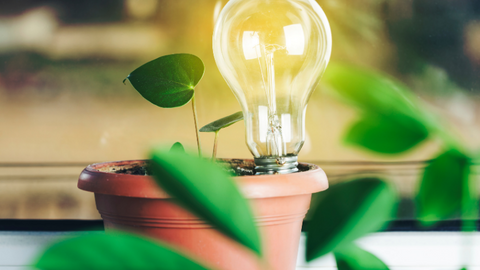If you've spent anywhere between 5 minutes and 5 hours learning about Grow Lights for Indoor Plants, you're probably feeling confused by terms like Watts, PPF, PPFD, PAR, and DLI. What do they all mean, and why should you care?
In this article, we’re going to:
- Explain what these terms about grow lights mean and why they are important.
- Show how these terms are measured and related.
- Provide practical examples for choosing a grow light for your indoor garden.
Buckle up, fellow plant nerds. Let's dive in!

The first step is to digest the diagram above. We’ll follow the ‘flow’ of energy from the wall socket, through the grow light, and onto the leaves of your plants.
If you're feeling overwhelmed, take a step back and check out our introduction: ‘Grow Lights – An Introduction for Indoor Gardeners’.
How Much Electricity Do Grow Lights Use?
Why Grow Light Wattage Is Not as Important as You Think
Grow light energy starts off as watts.
Wattage measures the rate of energy flow. For electricity, 1000 watts equals 1 kilowatt (kW). If you run a 1kW appliance for an hour, you’ve used 1 kWh. Your utility bill charges based on kWh consumption.
For example, a 20W grow light running for 14 hours a day would consume 102.2 kWh per year. At an average US electricity rate of $0.1054/kWh, it would cost $10.77 annually.
Use your utility bill’s rate to calculate the cost for your grow light. The US Energy Information Administration has a handy list of state rates.
What is PPF in Grow Lights?
To know how effective a grow light is at growing plants, we need to understand its efficacy, measured by PPF (photosynthetic photon flux).
PPF measures the number of photons emitted by a light source, specifically within the 400nm-700nm PAR (photosynthetically active radiation) range. Watts go in, PPF comes out. To gauge grow light efficacy, we divide PPF by watts (PPF/W).
What is Grow Light Efficiency and PPF/W?
PPF/W varies greatly between grow lights. More efficient lights provide more light per watt. For example, the best grow lights can output 10 times more light than the least efficient models.

Coefficient of Utilization for Grow Lights
The Coefficient of Utilization (CU) measures how much light that exits a fixture reaches the plant. If your plant occupies a 90-degree area beneath a light source emitting evenly in 360 degrees, the CU would be 0.25, meaning 75% of the light is lost.

Combining PPF/W and CU – An Example
Let’s compare two grow lights:
| Units | Light A | Light B | |
|---|---|---|---|
| Energy consumption | Watts | 100W | 50W |
| PPF/W | umol/j | 0.25 | 0.75 |
| CU | 0.6 | 0.8 | |
| PPF | umol/s | 15 umol/s | 30 umol/s |
How to Get the Most From Your Grow Light
The Importance of Distance for Grow Lights
PPFD (photosynthetic photon flux density) measures the amount of light that reaches the plant. Light intensity decreases as you move away from the light, following the inverse-square law, where doubling the distance reduces intensity by 75%.

How Long Should a Grow Light Be On? Understanding DLI
Daily Light Integral (DLI) measures the total amount of light a plant receives over a day. It’s a function of both light intensity (PPFD) and time. Fruiting plants like tomatoes need a DLI of 20-30 mol/m²/day, while decorative plants may need only 10 mol/m²/day.
Which Grow Light is Right for You?
If you’ve made it this far, great job! Here are some quick grow light recommendations:
- Best Hanging Option: The Aspect Grow Light in 20W or 40W, perfect for ceiling or wall hanging.
- Best Free-Standing Option: The PlantSpectrum, available in 16W and 32W, is waterproof and versatile.
- Best Under-Cabinet Option: The Grove Grow Light is ideal for small spaces like bookshelves or countertops.
- Most Versatile Option: The Vita Grow Light, compatible with most standard lamp fittings and available in a pendant kit.
- Best Budget Option: The Compact Grow Light is great for seed starting or small herb plants.







I love this information & it’s easy to understand when you broke it all down. I’m a high school agriculture teacher, but grow lights & indoor farming have always fascinated me. Thank you for teaching the teacher!
Good article, explains the various light influencers very well.
Please take anothe4r look at the math for the DLI calculations. The results are correct, but the math should be:
Light A: 667 × 14400 = 9,604,4800 not 667 × 114400.
Light B: 333 × 57600 / 1,000,000 not 333 / 57600 / 1,000,000.
Yes I’m in the market for a more efficient grow light. Please keep me informed on your light. I can’t find the PPFD for my nine anthurium andraeanum flowering plants?
Great overview of lighting requirements. Need to go back to my physics class to understand it well.